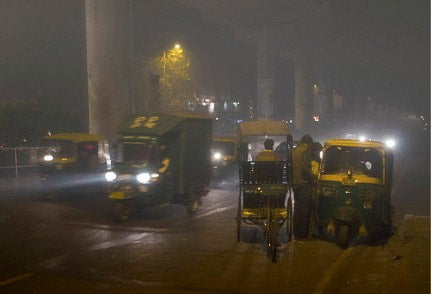|
June 22, 2014
Hot cities: Climate change may lead to air stagnation, Stanford scientists say
Computer simulations suggest climate change could lead to increased and prolonged air stagnation events in several regions of the world. These pockets of still air could contribute to hazardous air quality and impact human health. By Ker Than

Smog under a metro overpass in Delhi, India. Air quality in large-population areas such as this could worsen in the 21st century because of shifts in global wind and rainfall patterns caused by climate change, according to Stanford researchers. (Photo: Eric Parker / Flickr, Creative Commons)
Air quality for countries around the world could worsen in the 21st century as the occurrence of atmospheric stagnation events – in which still air lingers over a region – increases due to climate-change-related shifts in global wind and rainfall patterns, according to new research by scientists at Stanford University.
The finding, detailed in the current issue of the journal Nature Climate Change, suggests that population centers in several regions could experience more frequent pollution exposure that may, in turn, increase the public health risk of cardiovascular and respiratory illnesses.
"The World Health Organization estimates 3.7 million premature deaths per year are attributable to poor air quality. As such, it's a substantial public health issue facing the world today," said first author Daniel Horton, a postdoctoral researcher in the lab of Noah Diffenbaugh, an associate professor in the School of Earth Sciences.
Past research has looked at the effects of climbing temperatures and water vapor on the chemical reactions that affect different air pollutants, said Diffenbaugh, who is also a senior fellow at the Stanford Woods Institute for the Environment and the senior author of the new study. "Few studies have looked at how climate change will affect the meteorological conditions that allow pollutant concentrations to build up in the atmosphere," Diffenbaugh said.
In the new study, Diffenbaugh's group focused on air stagnation, a term that describes the conditions under which pollutants can accumulate in the atmosphere. To investigate the frequency and duration of future stagnation events, Diffenbaugh's group applied the National Climatic Data Center's air stagnation index to a collection of global climate models that use computers to simulate Earth's climate and environmental conditions in the current century.
The team used a scenario that assumes greenhouse gas concentrations continue to accumulate in the atmosphere at their current pace, causing global mean temperature to increase approximately 4 degrees Celsius by the year 2100.
For a day to count as "stagnant," three meteorological conditions had to be met: the absence of rain, little to no winds near the surface and light wind speeds aloft in the atmosphere.
"All three conditions have to occur simultaneously," Horton said. "If it doesn't rain on a particular day, but the winds are very strong, a stagnation event is not likely to occur."
According to the team's analysis, by the late 21st century more frequent air stagnation will affect areas covering approximately 55 percent of the current global population, with some regions potentially experiencing an increase of up to 40 stagnation days per year. "Due to the combination of high population densities and projected increases in stagnation occurrence, the regions with the greatest potential exposure risk are India and China," Horton said. "But Mexico, the Mediterranean and parts of the Western United States are also likely to be affected."
In addition to the projected increases in the frequency of stagnation events, the authors found that in some regions the events could last longer as well, which can further amplify pollutant accumulations. These trends could impact the level of pollutant management that is required to meet air quality targets, Diffenbaugh's team wrote.
"Since the 1960s, many nations have begun legislation-based initiatives to limit the amount of pollutants that can be emitted into the atmosphere. The U.S. policies have been effective at decreasing concentrations of the six most common pollutants by about 70 percent," Horton said. "Our new research suggests that global warming could impact some of that effectiveness by increasing the occurrence of stagnation. If so, the pollutants that do exist could accumulate more frequently, increasing the risk of poor air quality."
-30-
|